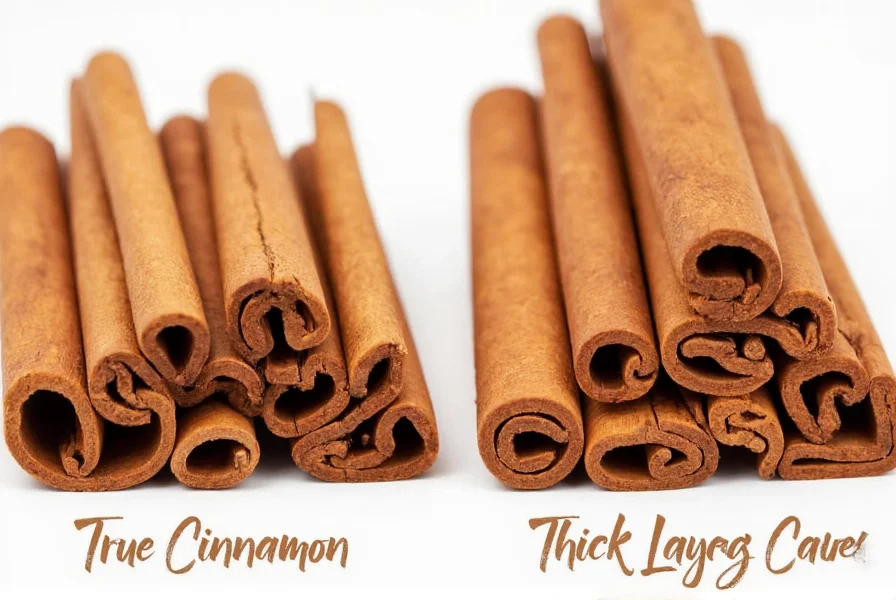True cinnamon sticks, scientifically known as Cinnamomum verum and commonly called Ceylon cinnamon, originate from Sri Lanka and southern India. They feature multiple delicate, papery layers that form a tight scroll, offering a subtle, citrusy flavor with significantly lower coumarin levels compared to the more common Cassia cinnamon.
When you reach for cinnamon in your kitchen, you're likely handling Cassia cinnamon rather than the genuine article. True cinnamon sticks represent a distinct variety that's prized by chefs and health-conscious consumers alike for their nuanced flavor profile and safety advantages. Understanding the difference isn't just culinary snobbery—it has practical implications for both your recipes and your health.
What Makes Cinnamon "True"?
The term "true cinnamon" specifically refers to Cinnamomum verum (formerly Cinnamomum zeylanicum), a species native to Sri Lanka. This botanical distinction separates it from the Cassia varieties (primarily Cinnamomum cassia) that dominate supermarket shelves. The "true" designation emerged historically when European traders sought the authentic spice from its original source, differentiating it from similar but distinct varieties.
True Cinnamon vs. Cassia: A Visual and Chemical Comparison
Identifying true cinnamon sticks requires attention to several physical characteristics that distinguish them from their Cassia counterparts:
| Characteristic | True Cinnamon (Ceylon) | Cassia Cinnamon |
|---|---|---|
| Appearance | Multiple thin, delicate layers forming a tight scroll (like a cigar) | Single thick, hard quill that's difficult to break |
| Color | Light tan to pale brown | Dark reddish-brown |
| Texture | Fragile, crumbles easily when bent | Hard, requires significant force to break |
| Taste Profile | Subtle, sweet, citrusy with complex notes | Intense, spicy, sometimes bitter |
| Coumarin Content | Approximately 0.017g/kg (very low) | Approximately 3.74g/kg (up to 250x higher) |

The Critical Health Consideration: Coumarin Content
One of the most significant differences between true cinnamon sticks and Cassia involves coumarin, a naturally occurring compound. While Cassia contains high levels of coumarin (up to 250 times more than Ceylon), true cinnamon's minimal coumarin content makes it the safer choice for regular consumption.
Health authorities have established acceptable daily intake levels for coumarin at 0.1 mg per kilogram of body weight. For a 150-pound adult, this translates to approximately 6.8 mg daily. Just one teaspoon of Cassia cinnamon can contain 5-12 mg of coumarin, potentially exceeding safe limits with regular use. Those with liver conditions or taking certain medications should be particularly mindful of this distinction when selecting cinnamon sticks for daily use.
How to Identify Authentic True Cinnamon Sticks
When shopping for genuine Ceylon cinnamon, look for these identifying features:
- Physical structure: True cinnamon sticks consist of multiple thin layers rolled inward, creating a delicate, almost hollow center. They'll break easily when bent.
- Color and texture: Expect a lighter tan color and a somewhat brittle texture compared to the dark, hard Cassia sticks.
- Labeling: Look for "Cinnamomum verum," "Ceylon cinnamon," or "true cinnamon" on packaging. Terms like "Mexican cinnamon" or "Chinese cinnamon" typically indicate Cassia varieties.
- Price point: Authentic Ceylon cinnamon usually costs 2-4 times more than Cassia due to its more labor-intensive harvesting process.
Culinary Applications for True Cinnamon Sticks
True cinnamon's delicate flavor profile shines in applications where its subtle notes won't be overwhelmed:
- Beverages: Simmer whole sticks in milk for traditional rice pudding or hot chocolate, where the gentle citrus notes enhance without dominating.
- Desserts: Use in delicate custards, fruit compotes, and poaching liquids for pears or apples where Cassia's intensity would overpower.
- Spice blends: Incorporate into Middle Eastern and Indian spice mixes like garam masala where authenticity matters.
- Infused sugars: Bury a stick in a sugar jar to create subtly flavored sugar for baking or beverages.
When substituting true cinnamon sticks for ground cinnamon in recipes, use a 3-inch stick to replace 1 teaspoon of ground cinnamon. Remember that true cinnamon's flavor is more delicate, so you may need slightly more than Cassia to achieve comparable intensity.
Where to Source Genuine Ceylon Cinnamon
Finding authentic true cinnamon sticks requires some diligence. Specialty spice retailers, both online and brick-and-mortar, typically offer higher quality and more accurate labeling than general grocery stores. Look for suppliers who specify the cinnamon's origin (Sri Lanka being the primary source of true cinnamon) and who provide information about harvesting practices.
When evaluating potential sources, check for third-party testing certifications that verify both species identification and coumarin levels. Reputable suppliers will often provide microscopic images showing the characteristic layered structure of genuine Ceylon cinnamon sticks.

Storage Recommendations for Maximum Freshness
To preserve the delicate flavor compounds in true cinnamon sticks, store them in an airtight container away from light and heat. Properly stored, whole sticks maintain their potency for 1-2 years, significantly longer than ground cinnamon. Avoid refrigeration, which can introduce moisture that degrades quality. For extended storage, consider freezing in an airtight container—this preserves volatile oils without compromising texture.











 浙公网安备
33010002000092号
浙公网安备
33010002000092号 浙B2-20120091-4
浙B2-20120091-4